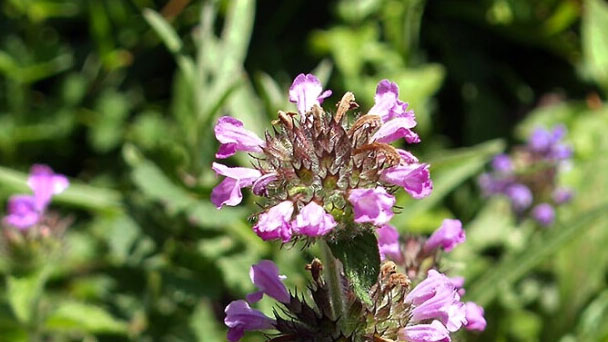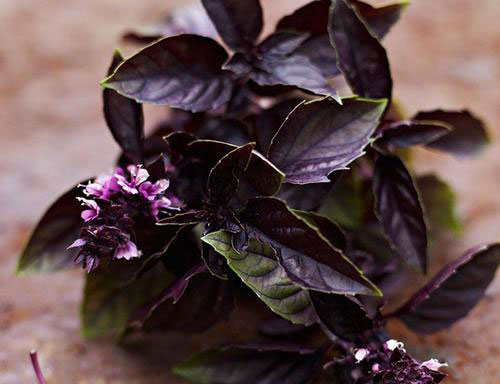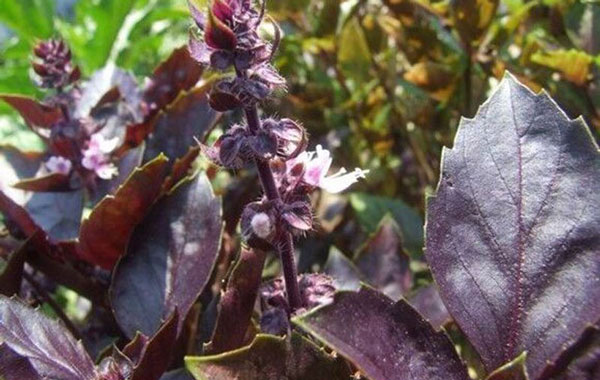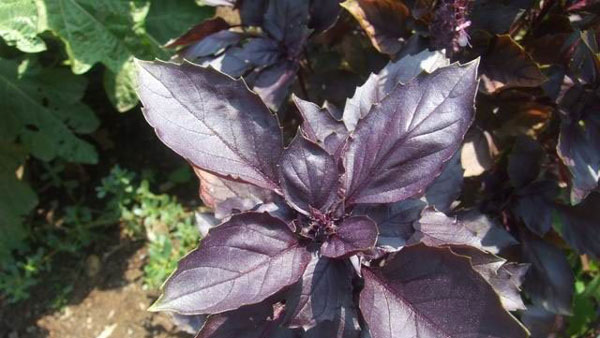Dark Opal Basil Grow & Care Guide
Written by Iris
Oct 22 2021

This sweet and very popular variety of basil has gorgeous purple-black glossy leaves and a delicious aroma. It is striking and a beautiful and colorful garden plant. This basil produces young leaves of small to medium size. It is a slow bolt and grows at a steady rate. Deep purple has a green metallic undertone or luster, and in bright light it can appear flat and open.

This is how to turn a scion into a new basil herb:
cut off five to ten shoots with a length of about ten centimeters and remove the leaves from the lower halves
place the shoots in a translucent vessel filled with water
position the cuttings in a light place but not exposed to the bright midday sun
renew the water every two to three days
as roots have developed after about a week, the cuttings can be planted in substrate together
keep the substrate constantly moist, but not too wet
optimal temperature: between 20 degrees Celsius and 24 degrees Celsius
best time for propagation: April

Where to Grow Dark Opal BasilHow to Grow Dark Opal BasilDark Opal Basil Propagation with SeedsDark Opal Basil Propagation with ScionHow to Care for Dark Opal BasilDark Opal Basil Light RequirementsDark Opal Basil Soil CareDark Opal Basil WateringDark Opal Basil Temperature & HumidityDark Opal Basil FertilizerDark Opal Basil PruningDark Opal Basil Pests & DiseasesDark Opal Basil Care FAQIs Dark Opal Basil the same as basil?Is Dark Opal Basil edible?Does Dark Opal Basil grow back?How long can Dark Opal Basil live?
Where to Grow Dark Opal Basil
Plant dark opal basil seeds/seedlings about ¼-inch deep and 10 to 12 inches apart. They should grow to about 12 to 24 inches in height. Basil will grow best in a location that gets 6 to 8 hours of full sun daily, though it can perform well in partial sun, too. Soil should be moist but well-drained. Basil works great in containers or raised beds, as these allow for better drainage. If you’re planning on cooking with Dark Opal Basil plants, plant in clean soil, don’t use insecticides, and grow them away from driveways and busy streets so that exhaust won’t settle on the plants.
How to Grow Dark Opal Basil
Dark Opal Basil Propagation with Seeds
- Plant seeds in a small pot, making a 1/4-inch indentation in the soil with your thumb. Use moist, sterile planting soil. Place the seed in the indentation and cover it with loose soil. “Water in” the basil by thoroughly saturating the soil. Place the pot near a sunny window. Keep the soil consistently moist during germination, which takes about 14 to 21 days.
- Select a planting site that receives full sunlight exposure. Dark opal basil prefers light, rich, well-drained soil with a pH range of 5.5 to 6.5. Amend the soil with 1 to 2 inches of manure and 4 to 6 inches of compost, working them into the top 6 to 8 inches of soil.
- Transfer the dark opal basil plant to this soil 6 weeks after planting it in the pot, during the spring when soil is warm. Make a hole big enough for the entire root system and water-in the plant by saturating the loose soil. Keep 18 inches of space between plants.
- Apply a 1-inch layer of organic mulch around the base of the plant to help it retain moisture.
- Provide the plant with 1.5 inches of water per week. Water the roots slowly and deeply.
- Pinch off growing flower buds by hand as they appear, to encourage bushier growth.
Dark Opal Basil Propagation with Scion
As an alternative to sowing, the Dark Opal Basil can also be propagated by using cuttings. Since this method is usually not successful using a potted mother plant from the supermarket, it is recommended to take the scions from a strong bed or balcony plant.This is how to turn a scion into a new basil herb:
cut off five to ten shoots with a length of about ten centimeters and remove the leaves from the lower halves
place the shoots in a translucent vessel filled with water
position the cuttings in a light place but not exposed to the bright midday sun
renew the water every two to three days
as roots have developed after about a week, the cuttings can be planted in substrate together
keep the substrate constantly moist, but not too wet
optimal temperature: between 20 degrees Celsius and 24 degrees Celsius
best time for propagation: April

How to Care for Dark Opal Basil
Dark Opal Basil Light Requirements
Unless you live in particularly hot regions, your dark opal basil will appreciate a full sun position. Ideally, they'll want at least six hours of full sun to thrive.Dark Opal Basil Soil Care
Not very picky about soil types, Dark Opal Basil just needs a well-drained variety that is not overly dry. Mulching can help dry soil retain water better, especially in hot areas, and adding organic material can be welcome if your basil is grown in a less rich medium.Dark Opal Basil Watering
Make sure that the soil is moist. Dark Opal Basil plants like moisture. If you live in a hot area, use mulch around the plants (the mulch will help hold in moisture and suppress weeds). During the dry periods in summer, water the plants freely.Dark Opal Basil Temperature & Humidity
The key to success is to place the dark opal basil in a hidden place. Without this, it is unlikely to flourish. Although the species can cope with hot, humid or dry conditions, it prefers cooler, milder areas. Too much heat means the leaves are more green than purple, and it affects their flavor intensity. The species is also very sensitive to frost and is best kept indoors if temperatures drop sharply overnight.Dark Opal Basil Fertilizer
Fertilizing your black opal basil regularly helps ensure healthy growth. However, you do need a balance. Overfertilizing can affect the intensity of the smell and make it less aromatic. This is because the plants will produce less oil. Make sure the fertilizer is not too strong and you don't use too much.Dark Opal Basil Pruning
When Dark Opal Basil seedlings have 3 sets of true leaves (not counting the initial seed leaves), pinch off the top set. Continue this pattern when harvesting, pruning each branch you harvest back to just above its first or second set of leaves. Keep pinching off flowers as your basil grows to extend its harvest time. Flowering will change the flavor of leaves and reduce leaf production. Like many herbs, basil does well with relatively heavy and frequent harvests or pruning.Dark Opal Basil Pests & Diseases
Slugs can be a problem, especially during the late spring and early summer. It is advisable to use natural slug control remedies such as beer traps and crushed egg shells as opposed to slug pellets. Aphids can also be a problem so best be vigilant and remove them with a jet of water or introduce a biological control method, such as ladybird larvae.
Dark Opal Basil Care FAQ
Is Dark Opal Basil the same as basil?
Opal basil has striking, dark-purple leaves, and a milder flavor than sweet basil, with hints of cinnamon, anise, mint, and clove. It's a beautiful accent to salads or other uncooked summer dishes, either in addition to or in place of sweet basil.Is Dark Opal Basil edible?
Dark Opal Basil is a pretty-looking, aromatic basil cultivar. This upright, bushy perennial is more frequently grown as an annual and has edible deep purple leaves.Does Dark Opal Basil grow back?
There are a few varieties of Dark Opal Basil , but all are cultivars of the same basil plant, which is a true annual. Therefore purple basil grows from seed and die again all in one season, and do not return year after year.How long can Dark Opal Basil live?
Dark Opal Basil may survive for two years before replanting in warm climates. An indoor basil plant with full sun and steady warm temperatures may last longer as well. Basil plants are sensitive to cold weather and frost. Before the weather turns, take steps to preserve your plant for the next yearLatest Updated
- Benefits of Bugleweed - 7 Science-backed Health Benefits
- Bugleweed Dangers & Side Effects - Is It Poisonous?
- How to Plant Evergreen Trees - What You Should Know
- When to Plant Evergreens - Grow Guide for Evergreen Trees
- 12 Wonderful Evergreen Shrubs for Your Garden
- 12 Popular Evergreen Plants with Pictures for Beginners
- When And How To Prune A Lilac Bush Like a Pro
- How to Grow & Care for Lilac Vine (Hardenbergia Violacea)
- Japanese Lilac Tree (Syringa Reticulata) Care & Propagation Guide
- Shumard Oak Pros and Cons - What to Know
Popular Articles
- Winter maintenance of Antirrhinum Majus
- How to Grow Terminalia Mantaly Tree
- How to Grow and Care for Crossostephium Chinense
- How to grow Antirrhinum Majus in spring
- Peristeria Elata (Dove Orchid) Profile: Info & Care Guide
- Underwatered Snake Plant (Sansevieria Trifasciata) - Signs And How To Fix
- How to Care for Brazilian Jasmine Plant (Mandevilla Sanderi)
- How to Grow & Care for Graptopetalum Purple Delight in Summer
- Rosa Chinensis (China Rose): Plant Growing & Care Tips
- How to Care for Baby Sun Rose (Aptenia Cordifolia)